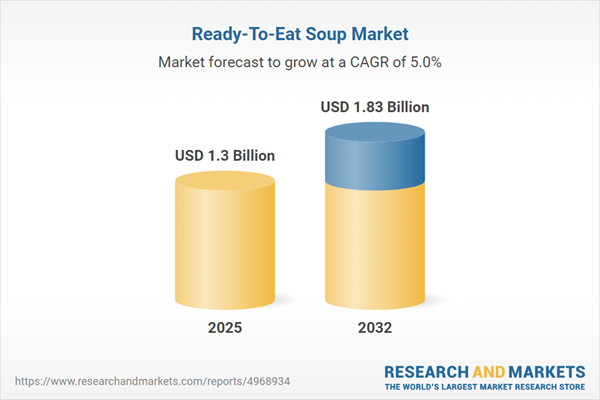Speak directly to the analyst to clarify any post sales queries you may have.
The ready-to-eat soup market is evolving rapidly as senior leaders must adapt to ongoing changes in regulations, consumer demands, and supply chain dynamics. Navigating this sector now requires a focus on agility, innovation, and optimized operational strategies to ensure sustained competitiveness and growth.
Market Snapshot: Ready-to-Eat Soup Market Growth and Competitive Landscape
The global ready-to-eat soup market is set for steady expansion, with annual sales rising from USD 1.24 billion in 2024 to USD 1.30 billion in 2025, and predicted to reach USD 1.83 billion by 2032. This represents a compound annual growth rate (CAGR) of 5.02% over the forecast period.
Sector growth is fueled primarily by heightened demand for convenience, prompting companies to innovate not only in product development but also in packaging solutions. Premium and niche varieties continue to broaden the consumer base, while new and established players adapt go-to-market strategies and strengthen presence across multiple retail channels. The current landscape emphasizes the necessity for operational excellence, flexibility, and regulatory compliance as manufacturers and retailers seek long-term relevance amid ongoing change.Scope & Segmentation: Ready-to-Eat Soup Market Overview
- Packaging Type: Bag, bowl, can, cup, and pouch formats are designed for practical storage, ease of transport, strong shelf presence, and effective logistics management. Many brands are advancing their use of environmentally responsible materials to meet sustainability targets.
- Temperature Range: Ambient, chilled, and frozen soup categories allow companies to target diverse regions and distribution environments, help limit product spoilage, and enable streamlined supply chain strategies.
- Product Source: Both conventional and organic soup options position brands to address a spectrum of value-driven and health-conscious consumer segments, supporting differentiation and aligning with wellness trends.
- Sales Channel: Supermarkets, hypermarkets, specialty food stores, convenience outlets, foodservice providers, and e-commerce each offer unique market access and help businesses build tailored growth strategies that adapt to local demand patterns.
- Regional Coverage: Americas, Europe, Middle East, Africa, and Asia-Pacific markets demand distinct approaches for regulatory adherence and supply chain optimization, shaped by local dietary preferences and logistic capabilities.
- Company Analysis: Leading companies—Campbell Soup Company, Unilever PLC, General Mills, Nestlé S.A., Conagra Brands, The Kraft Heinz Company, The Hain Celestial Group, McCormick & Company, B&G Foods, and Premier Foods plc—are evaluated for their technical innovation, strategic adaptability, and responsiveness to key global trends.
Key Takeaways: Strategic Insights for Senior Decision-Makers
- Premiumization and transparent sourcing are essential to build brand credibility, engage existing customers, and capture new market segments across traditional and emerging retail channels.
- Transitioning to recyclable and microwave-safe packaging meets evolving sustainability criteria from retailers and regulatory stakeholders.
- Advanced analytics and modern supply chain platforms provide real-time visibility, helping organizations quickly adjust inventories and seize market shifts.
- Effective product differentiation relies on tailoring offerings to regional and demographic preferences, which supports targeted distribution partnerships and regional expansion.
- Strengthening supply chain integration and contingency planning protects operational continuity amid shifting market and regulatory conditions.
- Broadening portfolios with organic and functional soups increases relevance with health-focused segments, facilitating stronger brand distinction in a crowded marketplace.
Tariff Impact: Supply Chain and Trade Considerations
Recent adjustments in U.S. tariffs have shifted industry focus toward domestic sourcing for key ingredients and packaging materials. This strategic move enhances sustainability initiatives and supply chain stability, encouraging further investment in automated processes. The adoption of automation also streamlines regulatory compliance and allows firms to better respond to market volatility and demand shifts within the international context.
Methodology & Data Sources
This report uses data from recognized industry databases, in-depth secondary research, and direct interviews with senior supply chain executives. The approach underscores how the market’s business models and strategic decisions are increasingly shaped by technological innovation and a focus on buyer-driven change.
Why This Report Matters: Actionable Insights for Ready-to-Eat Soup Market Stakeholders
- Segment benchmarking enables executive teams to realign investments and optimize portfolios as the business environment evolves.
- Actionable recommendations support robust risk management and streamline navigation through growing supply chain and regulatory complexity.
- Comprehensive intelligence underpins dependable operations and guides expansion into established and high-growth markets.
Conclusion
This research empowers senior leadership to enhance strategic planning, promote operational flexibility, and maintain a sustainable edge in the competitive ready-to-eat soup market.
Additional Product Information:
- Purchase of this report includes 1 year online access with quarterly updates.
- This report can be updated on request. Please contact our Customer Experience team using the Ask a Question widget on our website.
Table of Contents
3. Executive Summary
4. Market Overview
7. Cumulative Impact of Artificial Intelligence 2025
Companies Mentioned
The companies profiled in this Ready-To-Eat Soup market report include:- Campbell Soup Company
- Unilever PLC
- General Mills, Inc.
- Nestlé S.A.
- Conagra Brands, Inc.
- The Kraft Heinz Company
- The Hain Celestial Group, Inc.
- McCormick & Company, Incorporated
- B&G Foods, Inc.
- Premier Foods PLC
Table Information
| Report Attribute | Details |
|---|---|
| No. of Pages | 194 |
| Published | November 2025 |
| Forecast Period | 2025 - 2032 |
| Estimated Market Value ( USD | $ 1.3 Billion |
| Forecasted Market Value ( USD | $ 1.83 Billion |
| Compound Annual Growth Rate | 5.0% |
| Regions Covered | Global |
| No. of Companies Mentioned | 11 |









